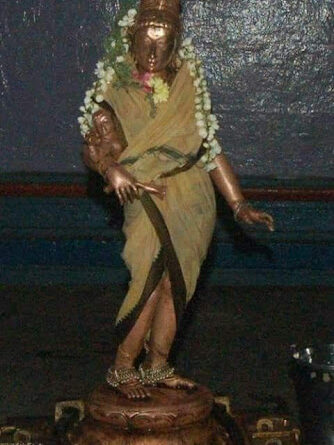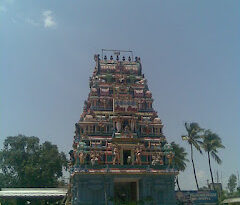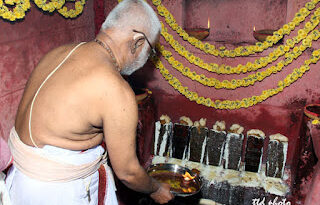Gajasamharamurti of Vazhuvoor
Tamil Nadu has many unique groups of temples dedicated to various groups of deities. Among such groups dedicated to Lord Siva are the “Ashta Veera Sthanams” or “Atta Veerattanams” as they are commonly known. These eight temples are known as “Veera Sthanams” or sites of valour because Lord Siva is believed to have performed one valorous feat in each of these sthalams:
1. Thirukkovilur – Andhakasura-vadha-murti – slaying the demon Andhaka
2. Thiruvadhigai – Tripurantakamurti – destroying the three cities of three asuras
3. Korukkai – Kamadahanamurti – burning Kamadeva or Manmatha with his third eye
4. Kandiyur – Brahma-shirashchhedaka-murti – cutting of Brahma’s fifth head as Bhairava
5. Thirukkadaiyur – Kalasamharamurti – saving Markandeya from Kala or Yama
6. Thiruppariyalur – Virabhadra – destroying Daksha’s yajna
7. Vazhuvur – Gajasamharamurti – slaying the rogue elephant
8. Thiruvirkudi – Jalandhara-vadha-murti – slaying the asura Jalandhara
The Veeratteshwarar temple in Vazhuvoor, a village in the Kuthalam taluk of Mayiladuthurai district of Tamil Nadu, is believed to be the site where Lord Siva killed Gajasura, the elephant demon, and wore his hide as a shawl.
The Rudra Samhita of the Siva Mahapurana contains an account of the story of Gajasura’s defeat at the hands of Lord Siva (Section 5 – Yuddha Khanda, Chapter 57). Gajasura was the son of Mahishasura who was killed by Goddess Durga as Mahishasuramardini. Wanting to take revenge for his father’s death, Gajasura did severe penance to propitiate Lord Brahma and obtained a boon from the creator god, “I shall not be killed by any man or woman who is overwhelmed by kama or lust.” As is the case with most asuras of yore, Gajasura began to terrorise all the worlds, and made his way to the city of Kashi, the capital city of Lord Siva. All the devas sought refuge in the Three-Eyed Lord who proceeded to Kashi to vanquish Gajasura and protect his devotees. After a long and terrible battle, the Lord who had burned Kama pierced Gajasura with his trisula, thus fulfilling the criterion of the demon’s boon. Realising his folly, Gajasura propitiated Lord Siva before giving up his life and asked for two boons –
यदि प्रसन्नो दिग्वासस्तदा दित्यं वसान मे।।
इमां कृत्तिं महेशान त्वत्त्रिशूलाग्निपाविताम् ।।५८।।
yadi prasanno Digvāsas-tadā dityam vasāna me
imām kṛttim Maheśāna tvat-triśūlāgni-pāvitām (verse 58)
Oh Sky-Clad Lord! Oh Maheśāna! If it pleases you, please wear this hide of mine which has been purified by the fire of your trident.
अन्यं च मे वरं देहि यदि तुष्टोऽसि शंकर ।।
नामास्तु कृत्तिवासास्ते प्रारभ्याद्यतनं दिनम् ।।६३।।
anyam ca me varam dehi yadi tuṣṭo`si Śaṅkara
nāmāstu Kṛttivāsāste prārabhyādyatanam dinam (verse 63)
Oh Śaṅkara! If you are pleased, grant me one more boon. From this day onwards, may you be known by the name Kṛttivāsa, one who wears the (elephant) hide.
Thenceforth, the Krittivaseshwara temple became one of the most important temples of Shiva in Kashi.
The Kurma Purana (Purvabhaga, chapter 32) has a slightly different version of the legend. Once, a daitya in the form of an elephant came to Varanasi and began to harass the sages who were performing penance and worshipping the Sivalinga. Lord Siva at once emerged out of the linga, killed the demon, tore his hide and wore it as a garment. Thus, he came to be known as Krittivaseshwara.
According to the sthala purana of the Vazhuvoor Veeratteshwarar temple, the sages who inhabited Darukavana (the forest of Daruka trees) became arrogant due to their spiritual prowess. Wanting to destroy their ego, Lord Siva took on the form of a mendicant, accompanied by Lord Visnu taking on his enchanting female form of Mohini, and the two of them entered the forest. While Visnu as Mohini distracted the sages, their wives were charmed by the handsome mendicant who had arrived. However, the sages soon realized that they were being cheated. They fuelled a great sacrificial fire out of which arose a great rogue elephant. When it attacked, Lord Siva entered its body. Unable to stand the fire of his presence in its belly, the elephant quickly entered the sacred spring called Pancha Brahma Teertha. The Lord then tore out of the body of the elephant and draped its hide around himself. The elephant here represents the ego which is torn out and destroyed once Lord Siva enters one’s heart.

It is believed that at the time of Pralaya (the great dissolution of the universe), the village of Vazhuvoor escaped unharmed (vazhuvudhal in Tamil means to slip away or escape) and hence came to be known as Vazhuvoor. The Veeratteshwarar temple in Vazhuvoor is the only temple dedicated to the Gajasamharamurti form of Lord Siva. This form is immortalised here as a beautiful 4-foot-high Chola bronze icon in a separate shrine, the largest and only one of its kind. Lord Siva as Gajasamharamurti stands with majestic ease on the head of the elephant. Out of his eight arms, two arms are holding up the hide of the elephant above his head. The two legs of the elephant are visible near the two hands holding up the skin, as well as the tail. The hide itself becomes the prabhamandala or tiruvaasi (ring of flames) surrounding the Lord. His other arms hold various weapons and objects such as a trisula (trident), kapaala (skull bowl), khadga and khetaka (sword and shield), and a snake. He stands with his left knee bent and lifted high. The fact that the sole of the lifted foot is visible in front as a result of the graceful twist of the torso is a testament to the skill and expertise of the Chola sculptor.

Next to the Lord is another beautiful bronze icon of Devi Parvati carrying her infant son Muruga or Karttikeya on her waist. She stands with her feet turned away from Lord Siva as if she is about to walk away, but her face is turned to look up at her husband in awe and fear at his terrible yet wonderous feat. The little Murugan on her waist is turned towards his father with one hand pointing to him. It is believed when Lord Siva did not emerge out of the elephant, Parvati became worried and dejected and began to turn away when young Muruga suddenly pointed and cried out that his father had torn through the elephant’s body and come out. This has been skilfully depicted in bronze here. Together, the bronze icons of this divine family is an awe-inspiring sight to behold.

Devi Parvati with the little Muruga on her right waist
Apart from the bronzes of Gajasamharamurti and Parvati Devi, other icons include those of Lord Siva as Bhikshatana (the mendicant) and Lord Vishnu as Mohini. The Sivalinga (moolavar) in this temple is a svayambhu lingam. The goddess is known as Balankurambikai or Ilankilai Nayaki. The mandapam or hall where the shrine of Gajasamharamurti is housed is known as Jnana Sabha. The teertha (sacred water source) here comprises of five wells and is hence known as Panchamukha Teertha or Panchabrahma Teertha. Usually the shrine for Nandi is followed directly by the shrine of Lord Siva. However in this temple, the temple tank lies between the Nandi shrine and the main shrine.

The temple tank with the gopuram
(photo by author)
Gajasamharamurti and Parvati with Muruga are the utsavamurtis of the temple. It is believed that the killing of the rogue elephant took place on the day of Maasi Magha (February-March), hence the Gaja-samhara is celebrated on that day every year when the utsavamurtis are brought out in procession.
Vazhuvoor is a very significant place in the field of Indian classical dance, and Bharatanatyam in particular. Among the major baanis or sub-styles in Bharatanatyam, “Natya Kala Kesari” Guru Vazhuvoor B. Ramaiah Pillai (1910-1991) was the fountainhead of the Vazhuvoor baani of Bharatanatyam. Till date, practitioners of this substyle begin their dance recitals with the traditional todayam or invocatory song of the Vazhuvoor Gajasamharamurti temple.
ஜய சுத்தபுரிவாஸ ஜய மஹாஞானசபேச
ஜய கஜசம்ஹாரேச ஜய க்ருத்திவாஸேச ஜய ஜய
ஶ்ரீ க்ருத்திவாஸேச்வரருக்கு ஜய மங்களம்
ஶ்ரீ பாலாங்குரம்பிகைக்கு சுப மங்களம்
பஞ்சப்ரஹ்மதீர்தகர்தருக்கு நித்ய மங்களம்
பக்த சுவாமிநாதனுக்கு க்ருபைசெய்ய நித்ய மங்களம்
jaya śuddhapurivāsa jaya mahājñānasabheśa
jaya Gajasamhāreśa jaya Kṛttivāseśa jaya jaya
Śrī Kṛttivāseśvararukku jaya maṅgaḷam
Śrī Bālāṅkurambikaikku śubha maṅgaḷam
Pañcabrahmatīrthakartarukku nitya maṅgaḷam
Bhakta Svāmināthanukku kṛpai seyya nitya maṅgaḷam
A rendition of this todayam by Guru Vazhuvoor R. Samraj (son of Guru Vazhuvoor Ramaiah Pillai) and the Bombay Sisters is there at the beginning of this YouTube video.
A most wonderful video of the utsavamurtis of the Vazhuvoor temple in procession is available on YouTube.
References:
The Śiva Purāṇa Part 2, transl. by J. L. Shastri. Motilal Banarsidass. Delhi. 2002.
Śiva Purāṇa (original Sanskrit) – Wikisource
The Kūrma Purāṇa Part 1. Motilal Banarsidass. Delhi. 1998.
Kūrma Purāṇa (original Sanskrit) – Wikisource
Vazhuvoor Veeratteshwarar sthala puranam – Shaivam.org
Location: Valuvur, Tamil Nadu 609401, India


